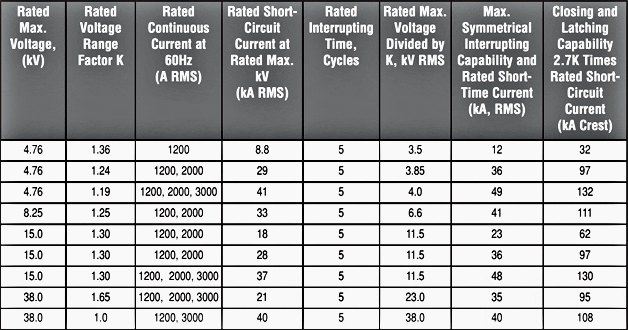MV protection applications
The medium voltage circuit breaker is the device of choice when sophisticated system protection at the medium voltage level is required. Most modern medium voltage circuit breakers use a vacuum as the interrupting means, although sulfur-hexafluoride (SF6) based units still exist and in use.

Medium voltage circuit breakers are generally not equipped with integral trip units as low voltage circuit breakers are. Instead, protective relays must be used to sense abnormal conditions and trip the circuit breaker accordingly. Most modern medium voltage circuit breakers are rated on a symmetrical current basis.
The following rating definitions apply:
Rated Maximum Voltage – The highest RMS phase-to-phase voltage for which the circuit breaker is designed.
Rated Power Frequency – The frequency at which the circuit breaker is designed to operate.
Rated Dry Withstand Voltage – The RMS voltage that the circuit breaker in new condition is capable of withstanding for 1 minute under specified conditions.
Rated Wet Withstand Voltage – The RMS voltage that an outdoor circuit breaker or external components in new condition are capable of withstanding for 10s.
Rated Lightning Impulse Withstand Voltage – The peak value of a standard 1.2 x 50µ s wave, as defined in IEEE Std 4-1978, that a circuit breaker in new condition is capable of withstanding.
Rated Continuous Current – The current in RMS symmetrical amperes that the circuit breaker is designed to carry continuously.
Rated Interrupting Time – The maximum permissible interval between the energizing of the trip circuit at rated control voltage and the interruption of the current in the main circuit in all poles.
Rated Short Circuit Current (Required Symmetrical Interrupting Capability) – The value of the symmetrical component of the short-circuit current in RMS amperes at the instant of arcing contact separation that the circuit breaker shall be required to interrupt at a specified operating voltage, on the standard operating duty cycle, and with a DC component of less than 20% of the current value of the symmetrical component.
Required Asymmetrical Interrupting Capability – The value of the total RMS short-circuit current at the instant of arcing contact separation that the circuit breaker shall be required to interrupt at a specified operating voltage and on the standard operating duty cycle.
This is based upon a standard time constant of 45ms (X/R ratio =17 for 60 Hz and 14 for 50 Hz systems) and an assumed relay operating time of _ cycle.
Rated closing and latching capability – The circuit breaker shall be capable of closing and latching any power frequency making current whose maximum peak is equal to or less than 2.6 (for 60 Hz power frequency; 2.5 for 50 Hz power frequency) times the rated short-circuit current.
Rated Short-Time Current – The maximum short-circuit current that the circuit breaker can carry without tripping for a specified period of time.
Maximum Permissible Tripping Delay – The maximum delay time for protective relaying to trip the circuit breaker during short-circuit conditions, based upon the rated short-time current and short-time current-carrying time period.
Rated Transient Recovery Voltage (TRV) – At its rated maximum voltage, a circuit breaker is capable of interrupting three-phase grounded and ungrounded terminal faults at the rated short-circuit current in any circuit in which the TRV does not exceed the rated TRV envelope.
Rated Voltage Range Factor K – Factor by which the rated maximum voltage may be divided to determine the minimum voltage for which the interrupting rating varies linearly with the interrupting rating at the rated maximum voltage by the following formula:
Ivop = Iv max · (Vmax / Vop)
where:
- Iv max – is the rated short-circuit current at the maximum operating voltage
- Vmax – is the rated maximum operating voltage
- Vop – is the operating voltage where Vop ≥ (Vmax / K)
- Ivop – is the short-circuit current interrupting capability where Ivop ≤ Iv max · K
For values of Vop below (Vmax÷ K) the short-circuit interrupting capability was considered to be equal to (Iv max · K). This model was more representative of older technologies such as air-blast interruption.
Because most modern circuit breakers employ vacuum technology, the current version assumes that K = 1., which gives the same short circuit rating for all voltages below the rated voltage. However, in practice designs with K > 1 still exist and are in common use.
Table 1: Preferred ratings for indoor circuit breakers with K=1.0

It should be noted that although 83 ms or 5 cycles is the “preferred” value for the rated interrupting time, 3-cycle designs are common.
Table 2:
Preferred ratings for indoor circuit breakers with voltage range factor K > 1.0

Few more words about MV CBs…
Medium voltage circuit breakers are typically provided without integral trip units. For this reason, custom protection must be provide via protective relays.
The circuit breaker internal control circuitry is arranged per IEEE C37.11-1997. Circuit breakers are also equipped with a number of auxiliary contacts to allow interlocking and external indication of breaker position.
For medium voltage protection applications, circuit breakers offer flexibility that cannot be obtained with fuses. Further, they do not require a separate switching device as fuses do.
These benefits are gained at a price
Circuit breaker applications are more expensive than fuse applications, both due to the inherent cost of the circuit breakers themselves and due to the protective relays required. For many applications, however, circuit breakers are the only choice that offers the flexibility required.
Large medium voltage services and distribution systems and most applications involving medium voltage generation employ circuit breakers.
Reference: System Protection – Bill Brown, P.E., Square D Engineering Services











Very good article.
Thanks for naration…
Good job Mr edvard! Your article was great! The information was really helpful :) Thanks I really admire you for this one.
Hi Ed….
Your effort is countless…Thanks for the clear narration…
As a Project Manager, I have to be more obliged by this article.
With regards
Ashraf Akkaraparambil
Hats off to you, Mr. Edvard, for selflessly disseminating the technical information at large, and thanks a lot for your initiative.
Very useful info..